The role of the garden is to support the teaching and research activities in the College; to achieve this, we have developed some interesting and unusual plant collections.
The Arboretum
An arboretum, from the Latin ‘arbor’ (tree) is, literally, a place where trees grow. Our arboreta cover approximately three-quarters of the garden and comprise over 700 trees and shrub species from across Europe, East Asia and the Americas.
Melianthus major: the walled garden provides perfect shelter for this tender South African native
The Walled Garden
The Walled Garden area forms the main core of the Botanic Gardens, containing the glasshouses, potting shed, administrative and laboratory buildings, and the order beds. Originally part of the walled garden of the adjacent hall which now forms part of the College’s student accommodation, it provides excellent shelter for tender species.
The Irish House
The Irish House contains our collection of native Irish species, together with some other cool temperate species. The collection also includes an important collection of species from turloughs, temporary waterbodies over karst limestone and almost unique to Ireland. They are listed as Priority Habitats under Annex 1 of the EU Habitats Directive and Trinity Botanic Garden is involved in on-going turlough conservation research.
The Stove House
The Stove House contains mostly tropical species, including various bromeliads, ferns and orchids. Many of these are epiphytic (epiphyte – a plant which grows on another plant, in this case usually a rain forest tree). To demonstrate how epiphytes grow in the wild, some here are grown as they would naturally, on cushions of moss fixed to logs.
The Cycad House
Contains a fine collection of cycads from Australia and SE Asia, bulbs, and many succulent plants from Mexico and South Africa. Many of the succulents growing here are unrelated to each other but show similar features, such as waxy leaves, spines, reduced leaves, all of which have evolved to cope with water shortage in arid environments and are an excellent resource for teaching plant morphology and adaptation.
The Long House
The Long House contains a large collection of insectivorous plants, which is important in teaching plant-animal interactions. There is also a large collection of temperate ferns, including tree ferns and the threatened native Killarney Fern, as well as many other interesting specimens.
Lawn Area
This is a lovely area for relaxing and enjoying the garden. In the lawn are good specimens of the elegant Handkerchief Tree (Davidia involucrata) – a spectacular site in late May when in full flower – and the interesting Black Mulberry (Morus nigra) which bears raspberry-like fruits in September. The lawn is bounded on two sides by a high stone wall and a deep herbaceous border on the western side.

